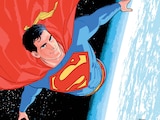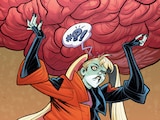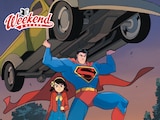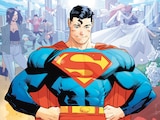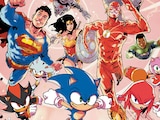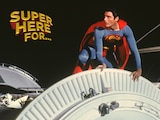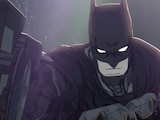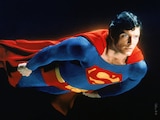One of the things I discovered when I first started hanging out with Denys Cowan and Dwayne McDuffie, founders of the comic book company Milestone Media, was that we all were deeply affected by the Black history comics we read when we were kids. So, when Denys and I relaunched Milestone Media decades later, we made creating a book that would have that same effect on this generation one of our priorities.
I called all these incredible writers I knew who would love to write one of these stories. Folks who had written best sellers. Historical experts. Brilliant comic book writers. Meanwhile Denys is reaching out to all these legendary artists he knew.
Alice Randall and I went to college together. She wrote the brilliant historical novel The Wind Done Gone, which was a parody of Gone with the Wind that was on the New York Times best seller list forever. She’s written hit country and western songs, she’s a professor at Vanderbilt and one of the smartest people I know, which is saying a lot because I know a few geniuses.

Alice took on two of the hardest stories. She wrote about “Lucy” who was the beginning of humanity, which started in Africa. It was very important to establish that we all have a common ancestor, and that she is African.
Alice also wrote about the incredible Pushkin family, which she had also researched for one of her novels. If all you read is the two chapters written by Alice, I promise you will be smarter by the time you finish. Just the section where she connects the concept of “the Golden Mean” with African architecture and the broader notion of how mathematics is integral to multiple forms of African expression is a game changer.
Steven Barnes and Tananarive Due are one of my favorite power couples because they are wonderful people with enormous talent. Steven is best known for his science fiction writing and Tananarive is known for her horror, but they are both very versatile authors. They both work in Hollywood now either separately or together. I asked each of them to write a story for the book. Steven and I had developed a project about the brilliant North African military leader Hannibal Barca a while back, so asking him to do that was a no brainer. Hannibal’s combat strategies are still studied in military schools today, and the visual of his army riding elephants over the Alps was too good to pass up.

I offered several different options to Tananarive, and she chose the Dumas family, who is one of my favorites. I first learned Alexandre Dumas, author of the most-read books of fiction in the history of the world (The Three Muskateers, The Man in the Iron Mask, The Count of Monte Cristo) was a Black man from reading a Black history comic book. In that same book, I found out those stories were based on the real-life adventures of his father, who was a rival to Napoleon in the French Army and a bad ass in his own right. Tananarive was intrigued and figured out how to squeeze all that information into four amazing pages.
Karyn Parsons and I became friends after I directed her in Ladies Man. Most folks know her from her iconic role as Hillary Banks in Fresh Prince of Bel-Air, but I also knew she wrote the Sweet Blackberry line of children’s books that featured historical Black legends. She took on one of the most important stories to me, Katherine Dunham, a pioneering dancer, choreographer, AND trained anthropologist who was determined to capture authentic African dance movement, no matter what the cost—including going to the most dangerous part of Haiti to submit to a voodoo ceremony!

Dunham went on to become a legendary choreographer whose students included Eartha Kitt and Marlon Brando and had a Hollywood career of her own before she came to my economically poor but culturally rich hometown of East St. Louis and created a college prep program that made it possible for my brother to go to Yale, which led to me going to Harvard. Karyn wrote an amazing story which told one incident out of a huge life and really makes you want to read more!
Touré and I have been friends for years. We worked together at BET and I have been a fan of his work as a journalist in Rolling Stone, the New York Times and on MSNBC; his books on race relations like Who’s Afraid of Post-Blackness and his amazing collection of short stories, The Portable Promised Land. As the author of two books on Prince (I Would Die for You and Nothing Compares to U), he’s also a literal Prince expert, so choosing him to write the Prince story was obvious.
Prince is a brilliant songwriter and performer, but the story chosen tells the story of his early years, including an incident as an opener for the Rolling Stones where rock and roll “fans” insulted and attacked the living embodiment of Chuck Berry and Little Richard, the founders of rock and roll.

Pat Charles and I have collaborated on film and television projects like Bones and Emperor, so I knew we shared a love for historical stories about Black heroes. We had talked about the action-packed life of Eugene Bullard, the “Black Sparrow of Death” who escaped lynching down south by stowing away to France where he became the first Black fighter pilot, then a spy in league with Josephine Baker!
This is the first work in the comic book medium for most of the writers on the project, even though they have distinguished careers in other mediums. But we did have a couple of comic writers on the project as well.
Melody Cooper writes for film, television, and comic books. I’m a fan of her work in any medium and her idea of combining the lives of Bessie Coleman, the first Black woman pilot and Mae Jemison, the first Black woman astronaut, into one story was brilliant!

Telling the story of a Black Jewish Queen was tricky, but Amy Chu was more than up for the task, not only telling her story, but also her importance across many cultures. I also love how she integrated Static and Rocket into the story—not as superheroes, but kids doing an assignment in school. Like me, I appreciate how Amy is putting her Harvard degree to good use writing comics!
I wrote the introduction to the book using Static and Icon & Rocket as narrators who spoke directly to the audience. The book ends with a preview of the next Milestone Comics event: Icon vs. Hardware! I won’t tell you what you see on the last panel, but it will explain why we ended Milestones in History with that segment!
While I was gathering writers, Denys was reaching out to artists. He contacted pioneering artists like Arvell Jones and Ron Wilson, who were some of the first Black artists to work at Marvel and DC Comics. They hired Denys when he was still a kid and showed him the ropes both as an artist and a Black man in an industry that was still uninterested in Black talent.

Denys also reached out to modern-day stars like Eric Battle, Ray-Anthony Height, Don Hudson, Dominike “Domo” Stanton and Jamal Igle—the next generation of Black artists. International talents Maria Laura Sanapo and the legendary Francesco Francavilla rounded out the creative team.
There are so many things I’m proud about with this book. I love the gender balance of both the figures profiled and the writers telling the stories. I’m proud of the historical sweep of the book from the roots of our humanity to reaching the stars. I’m proud of the scholarship, the writing, the art, and the editorial team assembling an incredibly complex 88-page book that is “all thriller, no filler.”
I also love the book for what it’s NOT—it’s not a retelling of Black history that starts with slavery and only focuses on racial oppression. It’s also not the same historical legends that inevitably end up in most “Black history” presentations. This book will feature people you can’t believe you’ve never heard of and facts you didn’t know about the people you have heard of. Most of all, no matter who you are, your game will be raised after you finish reading it. That’s a promise.
Milestones in History #1, a giant-sized new comic book featuring the heroes of Milestone narrating the real-life stories of historical Black trailblazers, is now available in print and as a digital comic book.

